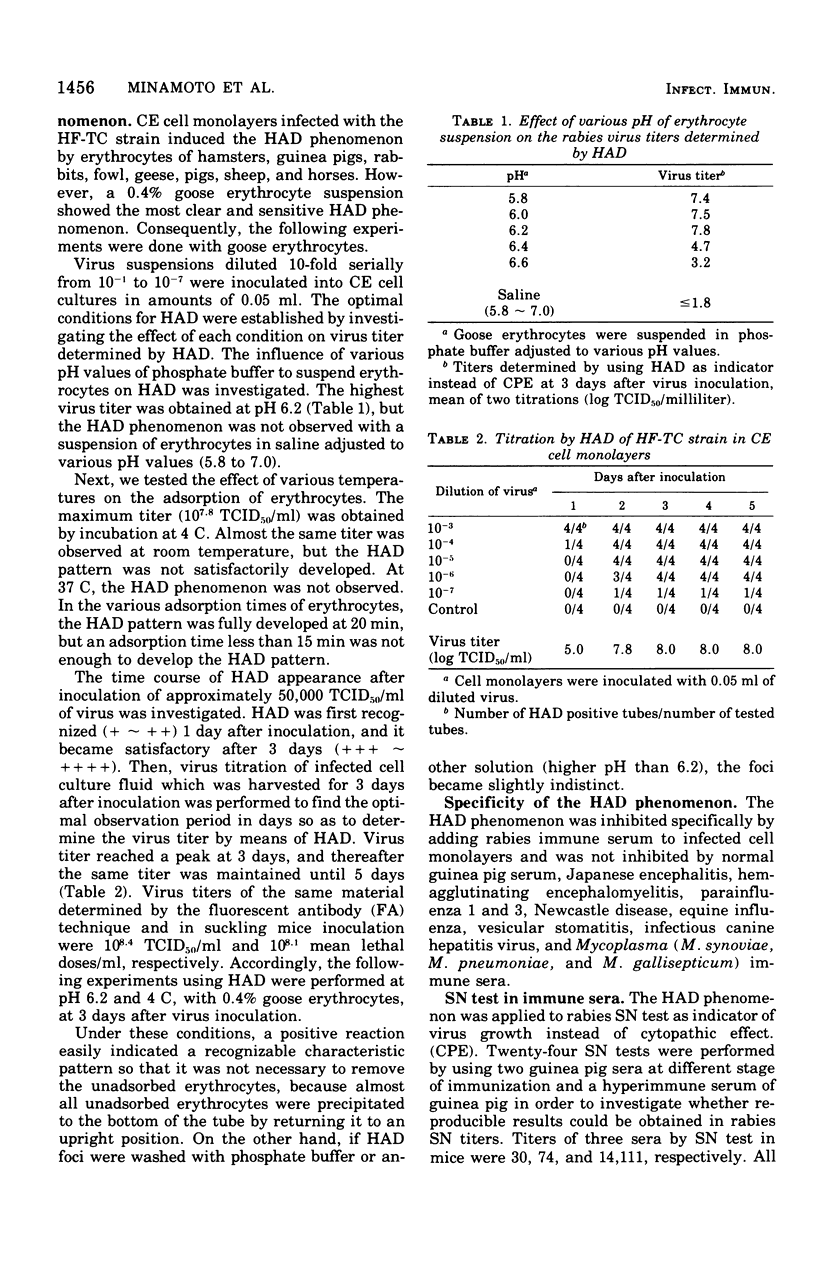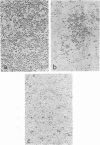Abstract
Chicken embryo cells infected with the HEP Flury strain of rabies virus adapted to tissue culture produced a hemadsorption (HAD) phenomenon by using goose erthyrocytes. The optimal conditions for HAD included the incubation of cell cultures at 37C for 3 days after virus inoculation, the use of a 0.4% suspension of goose erythrocytes in phosphate buffer adjusted at pH 6.2, and adsorption of erythrocytes at 4C. This phenomenon was inhibited with anti-rabies serum. Virus titer obtained with the HAD technique was almost the same as with the fluorescent antibody technique or the intracerebral inoculation of suckling mice. Results of the neutralization test by using the HAD technique could be easily determined 3 days after inoculation of chicken embryo cells with the mixture of 100 mean tissue culture infective doses of virus and diluted serum. The neutralizing antibody titers coincided with those obtained in mice.
Full text
PDF




Images in this article
Selected References
These references are in PubMed. This may not be the complete list of references from this article.
- Atanasiu P. Quantitative assay and potency test of antirabies serum and immunoglobulin. Monogr Ser World Health Organ. 1973;(23):314–318. [PubMed] [Google Scholar]
- DULBECCO R., VOGT M. Plaque formation and isolation of pure lines with poliomyelitis viruses. J Exp Med. 1954 Feb;99(2):167–182. doi: 10.1084/jem.99.2.167. [DOI] [PMC free article] [PubMed] [Google Scholar]
- Debbie J. G., Andrulonis J. A., Abelseth M. K. Rabies antibody determination by immunofluorescence in tissue culture. Infect Immun. 1972 Jun;5(6):902–904. doi: 10.1128/iai.5.6.902-904.1972. [DOI] [PMC free article] [PubMed] [Google Scholar]
- Halonen P. E., Murphy F. A., Fields B. N., Reese D. R. Hemagglutinin of rabies and some other bullet-shaped viruses. Proc Soc Exp Biol Med. 1968 Apr;127(4):1037–1042. doi: 10.3181/00379727-127-32864. [DOI] [PubMed] [Google Scholar]
- Kondo A. Growth characteristics of rabies virus in primary chick embryo cells. Virology. 1965 Oct;27(2):199–204. doi: 10.1016/0042-6822(65)90160-1. [DOI] [PubMed] [Google Scholar]
- Kuwert E., Wiktor T. J., Sokol F., Koprowski H. Hemagglutination by rabies virus. J Virol. 1968 Dec;2(12):1381–1392. doi: 10.1128/jvi.2.12.1381-1392.1968. [DOI] [PMC free article] [PubMed] [Google Scholar]
- Mengeling W. L. Hemadsorption plaque assay for hemagglutinating encephalomyelitis virus. Am J Vet Res. 1972 Oct;33(10):2075–2080. [PubMed] [Google Scholar]
- SHELOKOV A., VOGEL J. E., CHI L. Hemadsorption (adsorption-hemagglutination) test for viral agents in tissue culture with special reference to influenza. Proc Soc Exp Biol Med. 1958 Apr;97(4):802–809. doi: 10.3181/00379727-97-23884. [DOI] [PubMed] [Google Scholar]
- Sedwick W. D., Wiktor T. J. Reproducible plaquing system for rabies, lymphocytic choriomeningitis,k and other ribonucleic acid viruses in BHK-21-13S agarose suspensions. J Virol. 1967 Dec;1(6):1224–1226. doi: 10.1128/jvi.1.6.1224-1226.1967. [DOI] [PMC free article] [PubMed] [Google Scholar]
- Smith J. S., Yager P. A., Baer G. M. A rapid reproducible test for determining rabies neutralizing antibody. Bull World Health Organ. 1973 May;48(5):535–541. [PMC free article] [PubMed] [Google Scholar]
- VOGEL J., SHELOKOV A. Adsorption-hemagglutination test for influenza virus in monkey kidney tissue culture. Science. 1957 Aug 23;126(3269):358–359. doi: 10.1126/science.126.3269.358-a. [DOI] [PubMed] [Google Scholar]
- Yoshino K., Morishima T. An improvement in the plaque assay of rabies virus in chick embryo cells. Arch Gesamte Virusforsch. 1971;34(1):40–50. doi: 10.1007/BF01250244. [DOI] [PubMed] [Google Scholar]



